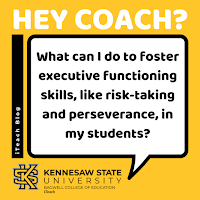Technology-Enhanced Learning Experiences in Early Education
 Hey Coach,
Hey Coach, I work with early learners, and I’m worried about their abilities to manage technology-based learning experiences. How can I prepare my young students for the digital world?
As a former kindergarten teacher, I can relate to your concern! When I first found out we had access to devices, I was very hesitant to use them. I was worried about proper handling, exposure to inappropriate material, and I didn’t think my kids would know how to operate the device. However, I was wrong! Look around you; kids of all ages are using technology. It is everywhere! I have even seen toddlers navigate the PBS Kids website in order to watch their favorite characters.
Clearly our students are using technology - It remains our job as educators to lead their technology use in productive ways that support our teaching and students’ learning. We can prepare students for this digital world in many different ways! To begin with, we can structure our classrooms for more student-centered learning experiences that encourage responsibility and independence. In doing so, we help students build executive function skills and set a strong foundation to activate learner agency within a personalized learning environment.
In order to foster student responsibility and independence with technology, learners must have explicit time to explore tools before they use them for learning experiences. As education strategist Joe Marquez states in his article, How Primary Students Can Use Technology Effectively, “...the youngest learners need good guidance and examples when it comes to engaging with technology in the classroom.” There are simple steps you can take to provide this guidance and set expectations:
- Just as you would teach any other classroom rule or procedure, take the time to recognize and discuss why there are rules for using technology and what these rules are.
- Model how to use digital resources and tools using an interactive projector.
- Take photographs and videos of students demonstrating appropriate behavior when learning with technology. Post pictures in the classroom and on your school or class website as visual reminders of expectations for technology use.
- Give students frequent opportunities to use technology tools like tablets, keyboards, and mice so they are able to learn through first-hand exposure and experience.
 |
| Digitize Early Learners |
Overall, it is important to remember that educational technology doesn’t replace essential learning experiences; rather, it enhances them. The National Association for the Education of Young Children reminds us in their review of Effective Classroom Practice that, “young children need tools that help them explore, create, problem solve, consider, think, listen and view critically, make decisions, observe, document, research, investigate ideas, demonstrate learning, take turns, and learn with and from one another”. Keep these essential needs in mind, and it will be easier to consider how you can support the 21st century learner.
The best way to prepare our littlest learners for a digital world is to give them authentic, meaningful opportunities to engage with technology. When you’re ready to plan for technology integration in your classroom, you might find our Technology and Early Learners handout helpful. It includes four questions to consider when planning technology-enhanced learning experiences, along with suggested tools that are ideal for the early education classroom. Once you can overcome that fear of putting technology in the hands of young students, you’ll be amazed at what they are able to learn, create, and share!
Best wishes,
Coach
Contributing Coaches Hannah Rome and Anna Bilyeu
Coach
Contributing Coaches Hannah Rome and Anna Bilyeu



Comments
Post a Comment